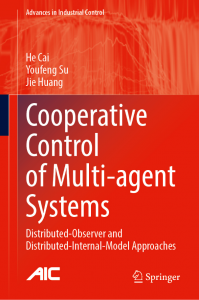
Title: Cooperative Control of Multi-agent Systems: Distributed-Observer and Distributed-Internal-Model Approaches
Authors: He Cai, Youfeng Su, Jie Huang
Press: Springer
Year: 2022
Language: English
ISBN: 978-3030983765
Pages: 409
Abstract:
The main focus of this book is a pair of cooperative control problems: consensus and cooperative output regulation. Its emphasis is on complex multi-agent systems characterized by strong nonlinearity, large uncertainty, heterogeneity, external disturbances and jointly connected switching communication topologies. The cooperative output regulation problem is a generalization of the classical output regulation problem to multi-agent systems and it offers a general framework for handling a variety of cooperative control problems such as consensus, formation, tracking and disturbance rejection.
The book strikes a balance between rigorous mathematical proof and engineering practicality. Every design method is systematically presented together with illustrative examples and all the designs are validated by computer simulation. The methods presented are applied to several practical problems, among them the leader-following consensus problem of multiple Euler–Lagrange systems, attitude synchronization of multiple rigid-body systems, and power regulation of microgrids. The book gives a detailed exposition of two approaches to the design of distributed control laws for complex multi-agent systems―the distributed-observer and distributed-internal-model approaches. Mastering both will enhance a reader’s ability to deal with a variety of complex real-world problems.
Cooperative Control of Multi-agent Systems can be used as a textbook for graduate students in engineering, sciences, and mathematics, and can also serve as a reference book for practitioners and theorists in both industry and academia. Some knowledge of the fundamentals of linear algebra, calculus, and linear systems are needed to gain maximum benefit from this book.